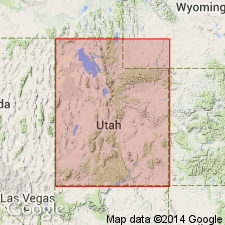
- Usage in publication:
-
- Beaver Member*
- Modifications:
-
- Original reference
- Geochronologic dating
- AAPG geologic province:
-
- Great Basin province
Summary:
Pg. B14-B15. Beaver Member of Mount Dutton Formation. Consists of pink to gray dacite porphyry containing 40 to 50 percent large phenocrysts (plagioclase, hornblende, biotite) that average 1 to 2 mm in diameter but, in the case of plagioclase, commonly exceed 1 cm, set in a dense light to dark gray vitric groundmass. Thickness 100 to 20 m. Intercalated with an unnamed flow-volcanic member of the Mount Dutton. Age is latest Oligocene and earliest Miocene based on radiometric (K-Ar) ages of 25.5 +/-0.5 Ma and 24.4 +/-0.8 Ma.
Type section: canyon of South Creek about 8 km (5 mi) south of town of Beaver, in SW/4 sec. 12, T. 30 S., R. 7 W., [Kane Canyon 7.5-min quadrangle], Beaver Co., southwestern UT.
Source: US geologic names lexicon (USGS Bull. 1520, p. 22-23); GNU records (USGS DDS-6; Menlo GNULEX).
For more information, please contact Nancy Stamm, Geologic Names Committee Secretary.
Asterisk (*) indicates published by U.S. Geological Survey authors.
"No current usage" (†) implies that a name has been abandoned or has fallen into disuse. Former usage and, if known, replacement name given in parentheses ( ).
Slash (/) indicates name conflicts with nomenclatural guidelines (CSN, 1933; ACSN, 1961, 1970; NACSN, 1983, 2005, 2021). May be explained within brackets ([ ]).

